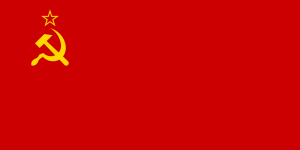The Soviet Union, officially the Union of Soviet Socialist Republics (USSR), was a socialist state in Eurasia from 1922-1991 that synthesized Marxism-Leninism, defeated fascism, and ultimately fell to revisionism in 1956. Established by the Communist Party of the Soviet Union (CPSU) in the aftermath of the Russian Civil War, the USSR was led by Vladimir Lenin until his death in 1924 and set a precedent for Leninism as a tradition of how socialist states should function. Joseph Stalin came to power after Lenin and began a process of reindustrialization, and later leading the USSR to victory in the Great Patriotic War against fascism from in 1941-1945. It was under Stalin that Marxism-Leninism was officially synthesized, religion reconcilied with Communism, and the precedant of socialist patriotism was reaffirmed. Stalin's death in 1953 led to the usurping of the country by Nikita Khrushchev, who abolished the dictatorship of the proletariat in 1956 and turned the country towards social imperialism. The Khruschev era ultimately contributed to the death of the country in 1991 due to the a wave of color revolutions and severe mismanagement by Mikhail Gorbachev.
The USSR continues to have a strong legacy among the post-Soviet states. To this day, the USSR is remembered as the greatest time in history according to 75% of Russians, 54% of Belarusians, and an uncalculated majority of Kazakhs.[1][2][3] Vladimir Lenin has a 56% approval rating in Russia today.[4] Even higher, Joseph Stalin has a 70% approval rating in modern Russia.[5] Stalin's approval in Georgia and Armenia also remains relatively high, at 45% and 38% respectively.[6]
References
- ↑ 75% of Russians Say Soviet Era Was 'Greatest Time' in Country’s History – Poll
- ↑ In Russia, nostalgia for Soviet Union and positive feelings about Stalin
- ↑ Kazakhstan's Soviet Legacy
- ↑ Russian Support for Vladimir Lenin Peaks Ahead of Bolshevik Revolution Centennial
- ↑ Stalin’s Approval Rating Among Russians Hits Record High – Poll
- ↑ Poll Finds Stalin's Popularity High
